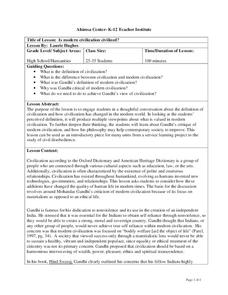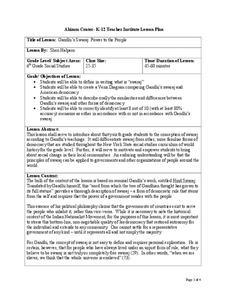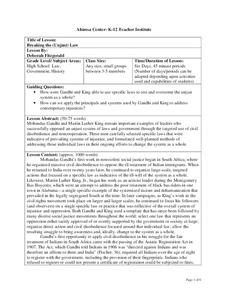Curated OER
Non-Violence Means "Doing Nothing"
Learners reflect on violence and non-violence. In this World History lesson, students read an article by Gandhi then write an essay as to whether they agree or disagree with his thoughts. Learners then share all their ideas as a class.
Curated OER
Mohandas Gandhi: Changing the World One Step at a Time
Students illustrate pages of a book. For this famous historical icon lesson, students are read a story about Mohandas Gandhi, illustrate the pages in small groups, assemble a class book to read to younger students, and act out a scene...
Facing History and Ourselves
Eyes on the Prize Lesson 1: The Philosophy of Nonviolence
Students explore the concept of nonviolent demonstration. In this Civil Rights Movement activity, students investigate examples of injustice and discuss the philosophy of nonviolence fueled by leaders of the movement. Students apply...
Curated OER
The March from Selma to Montgomery
Students examine voter discrimination. In this Civil Rights lesson, students watch segments of "Eyes on the Prize" and discuss the organization of the march from Selma to Montgomery. Students conduct interviews to learn personal stories...
Curated OER
Nonviolence as a Tool for Change Lesson 1
Students examine voting rights in the South during the 1950s and 1960s. In this civil rights lesson, students examine legal rights and the opportunity to cast votes. Students research primary documents regarding the topic and share their...
Facing History and Ourselves
Eyes on the Prize Lesson 2: Six Steps for Nonviolent Social Change
Young scholars explore the concept of nonviolent protest. For this Civil Rights lesson, students examine the attributes of nonviolent protest as they investigate the student protests that took place in Nashville in 1960-1961. Young...
Curated OER
Nonviolence as a Tool for Change Lesson 2
Young scholars explore nonviolent protest. In this Civil Rights lesson, students read the essay "Nonviolence and Racial Justice." Young scholars present the information they gleaned from the essay to their classmates in order to consider...
Curated OER
GANDHI'S INDIA
Young scholars describe key events in the life of Gandhi. They determine why knowledge of geography is necessary to understand the history of the people in a place or region. They write a summary of how the events in Gandhi's life,...
Curated OER
A Comparison of Two Great Leaders: Mahatma Gandhi and Martin Luther King Jr.
Students explore these two leaders use of nonviolent protest techniques. They read about the life of King Jr. They view a slide show about the life of Gandhi. Compare/contrast the lives of these two men using a Venn diagram.
Curated OER
Nonviolent Leaders
Students compare the life of Gandhi and other nonviolent leaders. They identify qualities and behaviors of nonviolence. They synthesize the information they research about world leaders and the impact they had.
Curated OER
Mahatma Gandhi: My Freedom Fighter
While this presentation only provides a limited amount of information about Mahatma Gandhi, it could be used as an example for a student research project. The 7 slide presentation highlights key information about Gandhi's life. It could...
Curated OER
20th Century Civil Disobedience
Students write from varying perspectives in the American South about the civil rights movements in the 1950s. In this civics lesson plan, students view video clips and take notes. Students discuss the film and listen to a lecture on...
Curated OER
The Art of Nonviolence: Martin Luther King, Jr., Gandhi, and Concepts of Nonviolence in Indian Art
Young scholars make connections between nonviolent ideals and art. In this visual arts lesson, students discuss the successes of the American Civil Rights Movement and discuss Gandhi's influence on the movement. Young scholars then...
Curated OER
World War II, India, Gandhi, and Pakistan
In this Asian studies activity, students read the noted pages in their textbooks and then respond to 12 short answer questions about Southeast Asia, World War II, Gandhi, India, and Pakistan.
Curated OER
Historical People of Asia
In this Asian history learning exercise, learners respond to 17 questions that require them to identify historical figures from the continent and list biographical information about each of them.
Curated OER
Classroom Management Using Gandhian and Kingian Principles of Nonviolence
Tenth graders study the concept of civil disobedience. For this Current Events lesson, 10th graders participate in a survey that nominates students for hard work and exemplifies nonviolence.
Curated OER
Satyagraha, Its Origins and Applications
Tenth graders study the steps and methods taken by Gandhi. In this World History lesson, 10th graders create illustrations to represent these steps. Students write a persuasive essay on these measures taken by Gandhi.
Curated OER
Another Perspective on Modern Civilization
Students consider the impact of current issues on the world population. In this global studies lesson, students discuss the pros and cons of modernization after they listen to a lecture about Gandhi's opinion of modern civilization....
Curated OER
Gandhi's Childhood Experience of Truth and Nonviolence
Fourth graders investigate philosophy by researching the life of Mahatma Gandhi. For this historical biography lesson, 4th graders examine the peaceful philosophy of India's most famous resident. Students participate in role-playing...
Curated OER
Is Modern Civilization Civilized?
Students examine the concept of civility. In this modern civilization lesson, students study Gandhi's teaching about the attributes of civilized societies and discuss how they can contribute to fostering civilization in their own community.
Curated OER
Give Peace A Chance: Nonviolence as a valid strategy for social change
Students analyze how people solve conflicts. In this conflict resolution instructional activity, students look at Mahatma Gandhi and Martin Luther King's nonviolence movements. They see the reasoning behind nonviolence and how it works.
Curated OER
Gandhi's Swaraj: Power to the People
Sixth graders discover what a swaraj is. In this world history lesson, 6th graders create a Venn Diagram comparing Gandhi's swaraj to American's democracy.
Curated OER
The Power of Nonviolent Struggle
Students identify how Mohandas Gandhi developed a nonviolent crusade for justice. In this nonviolent protest instructional activity, students watch segments of a documentary about Gandhi's reaction to imperialism in India. Students write...
Curated OER
Breaking the Unjust Law
Students consider the concept of civil disobedience. In this lesson on changing unjust laws, students use primary sources to understand how Gandhi and King changed the law. Students will then list laws that they feel are unjust and plan...

























